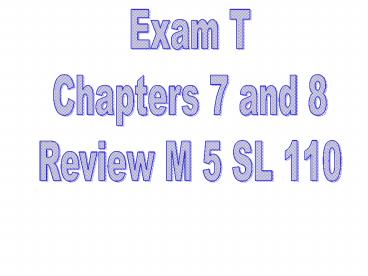Exam T - PowerPoint PPT Presentation
1 / 43
Title: Exam T
1
Exam T Chapters 7 and 8 Review M 5 SL 110
2
Periodicity of First Ionization Energy (IE1)
Like Figure 8-18
3
Fig. 8.15
4
(No Transcript)
5
Identifying Elements by Its Successive
Ionization Energies
Problem Given the following series of
ionization energies (in kJ/mol)
for an element in period 3, name the element and
write its electron
configuration
IE1 IE2 IE3
IE4 580
1,815 2,740
11,600 Plan Examine the values to find the
largest jump in ionization energy,
which occurs after all valence electrons have
been removed. Use the periodic
table! Solution
6
Identifying Elements by Its Successive
Ionization Energies
Problem Given the following series of
ionization energies (in kJ/mol)
for an element in period 3, name the element and
write its electron
configuration
IE1 IE2 IE3
IE4 580
1,815 2,740
11,600 Plan Examine the values to find the
largest jump in ionization energy,
which occurs after all valence electrons have
been removed. Use the periodic
table! Solution
The largest jump in IE occurs after IE3 so the
element has 3 valence electrons thus it is
Aluminum ( Al, Z13), its electron configuration
is
1s2 2s2 2p6 3s2 3p1
7
Fig. 8.16
8
Ranking Elements by First Ionization Energy
Problem Using the Periodic table only, rank the
following elements in each
of the following sets in order of increasing
IE! a) Ar, Ne, Rn b) At, Bi, Po c)
Be, Na, Mg d) Cl, K, Ar Plan Find their
relative positions in the periodic table and
apply trends! Solution
9
Ranking Elements by First Ionization Energy
Problem Using the Periodic table only, rank the
following elements in each
of the following sets in order of increasing
IE! a) Ar, Ne, Rn b) At, Bi, Po c)
Be, Na, Mg d) Cl, K, Ar Plan Find their
relative positions in the periodic table and
apply trends! Solution
a) Rn, Ar,Ne These elements are all noble
gases and their IE
decreases as you go down the group.
10
Suggested problems for Chapter 9
19, 20, 21, 22, 23, 25, 27, 29, 35, 37, 39, 43,
47, 49, 51, 53, 55, 56, 60, 62, 65, 79, 85, 93,
95, 96, 97 103, 105, 107
11
Chapter 9 - Models of Chemical Bonding
9.1) Atomic Properties and Chemical Bonds 9.2)
The Ionic Bonding Model 9.3) The Covalent
Bonding Model 9.4) Between the Extremes
Electronegativity and Bond Polarity 9.5) An
Introduction to Metallic Bonding
12
(No Transcript)
13
Sodium Chloride
14
Depicting Ion Formation with Orbital Diagrams and
Electron Dot Symbols - I
Problem Use orbital diagrams and Lewis
structures to show the formation of magnesium
and chloride ions from the atoms, and determine
the formula of the compound. Plan Draw the
orbital diagrams for Mg and Cl. To reach filled
outer levels Mg loses 2 electrons, and Cl will
gain 1 electron. Therefore we need two Cl atoms
for every Mg atom. Solution
Mg
Mg2 2 Cl-
..
2 Cl
.
..
..
..
.
Cl Cl
.
..
..
..
..
Mg
Mg2 2 Cl
.
..
..
15
Depicting Ion Formation from Orbital Diagrams and
Electron Dot Symbols - II
Problem Use Lewis structures and orbital
diagrams to show the formation of potassium and
sulfide ions from the atoms, and determine the
formula of the compound. Plan Draw orbital
diagrams for K and S. To reach filled outer
orbitals, sulfur must gain two electrons, and
potassium must lose one electron. Solution
2 K
2 K S - 2
S
..
.
.
2 -
.
..
..
..
..
..
K
.
S
2 K S
K
16
Three Ways of Showing the Formation ofLi and F
- through Electron Transfer
17
Lewis Electron-Dot Symbols for Elements in
Periods 2 3
18
The Reaction between Na and Br to Form NaBr
The Elements
The Reaction!
19
Vaporizing an Ionic Compound
20
Melting and Boiling Points of Some Ionic
Compounds
Compound mp( oC)
bp( oC)
CsBr 636
1300 NaI
661
1304 MgCl2
714 1412 KBr
734
1435 CaCl2
782
gt1600 NaCl 801
1413 LiF
845
1676 KF
858
1505 MgO 2852
3600
21
(No Transcript)
22
Figure 9.11 Potential-energy curve for H2.
23
Covalent Bonding in Hydrogen, H2
24
(No Transcript)
25
Figure 9.10 The electron probability
distribution for the H2 molecule.
26
Covalent bonds
http//wine1.sb.fsu.edu/chm1045/notes/Bonding/Cova
lent/Bond04.htm
animation
http//www.chem.ox.ac.uk/vrchemistry/electronsandb
onds/intro1.htm
27
For elements larger than Boron, atoms usually
react to develop octets by sharing electrons. H,
Li and Be strive to look like He. B is an
exception to the noble gas paradigm. Its happy
surrounded by 6 electrons so the compound BH3 is
stable. Try drawing a Lewis structure for
methane.
28
Draw Lewis dot structures for the halogens.
Notice that these all follow the octet rule!
Try oxygen and nitrogen.
These also follow the octet rule!
29
Bond Lengths and Covalent Radius
30
Figure 9.14 The HCl molecule.
31
The Charge Density of LiF
Fig. 9.20
32
Figure 9.12 Molecular model of nitro-glycerin.
What is the formula for this compound?
33
Rules for drawing Lewis structures
1. Count up all the valence electrons
2. Arrange the atoms in a skeleton
3. Have all atoms develop octets (except those
around He)
34
Make some Lewis Dot Structures with other
elements
SiH4
H2O
NH3
CH2O
C2H6
C2H6O
35
Figure 9.9 Model of CHI3Courtesy of Frank Cox.
CH3I
36
Make some Lewis Dot Structures with other
elements
CH4
H2O
NH3
CH2O
C2H6
C2H6O
37
Look at all these structures and make some
bonding rules
38
(No Transcript)
39
Rules for drawing Lewis structures
1. Count up all the valence electrons
2. Arrange the atoms in a skeleton
3. Have all atoms develop octets (except those
around He)
4. Satisfy bonding preferences!
40
A model of ethylene.
41
A model of acetylene.
42
Figure 9.14 The HCl molecule.
43
A model of COCl2.

